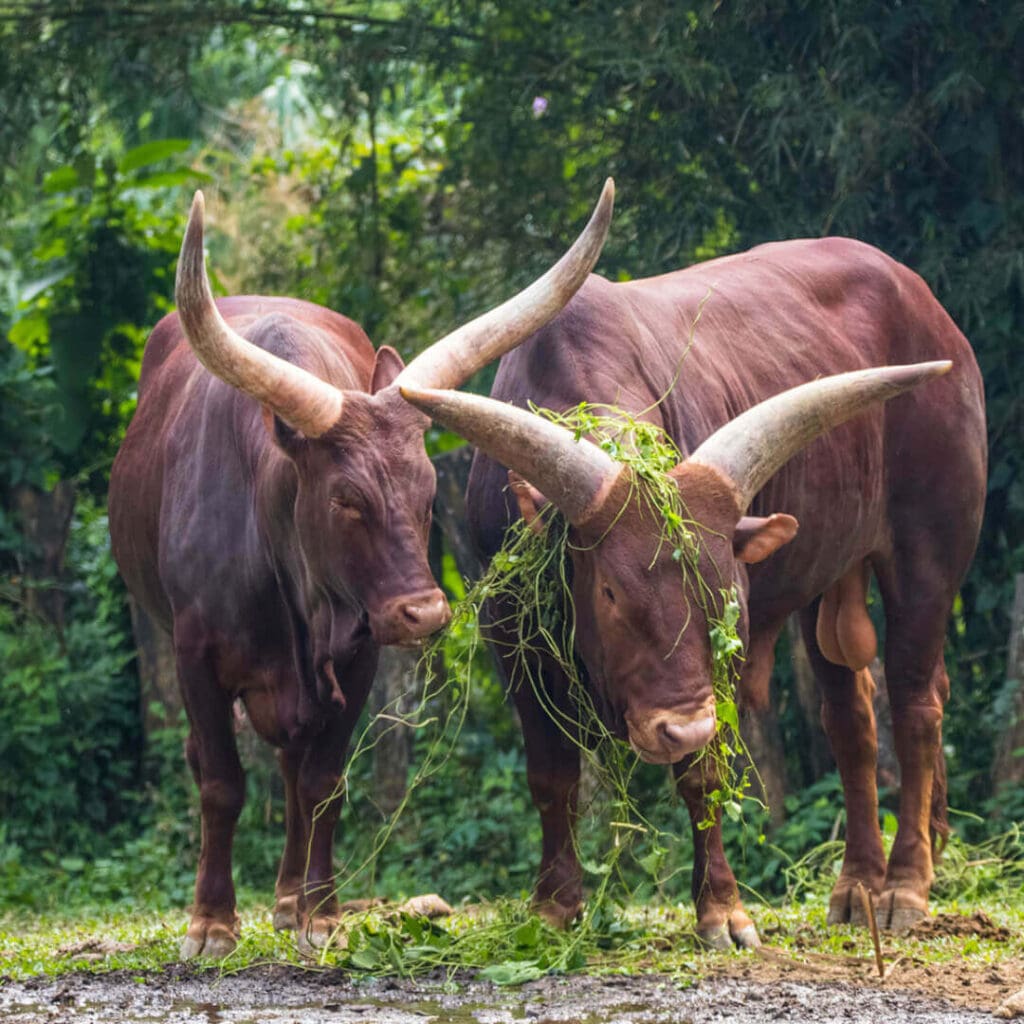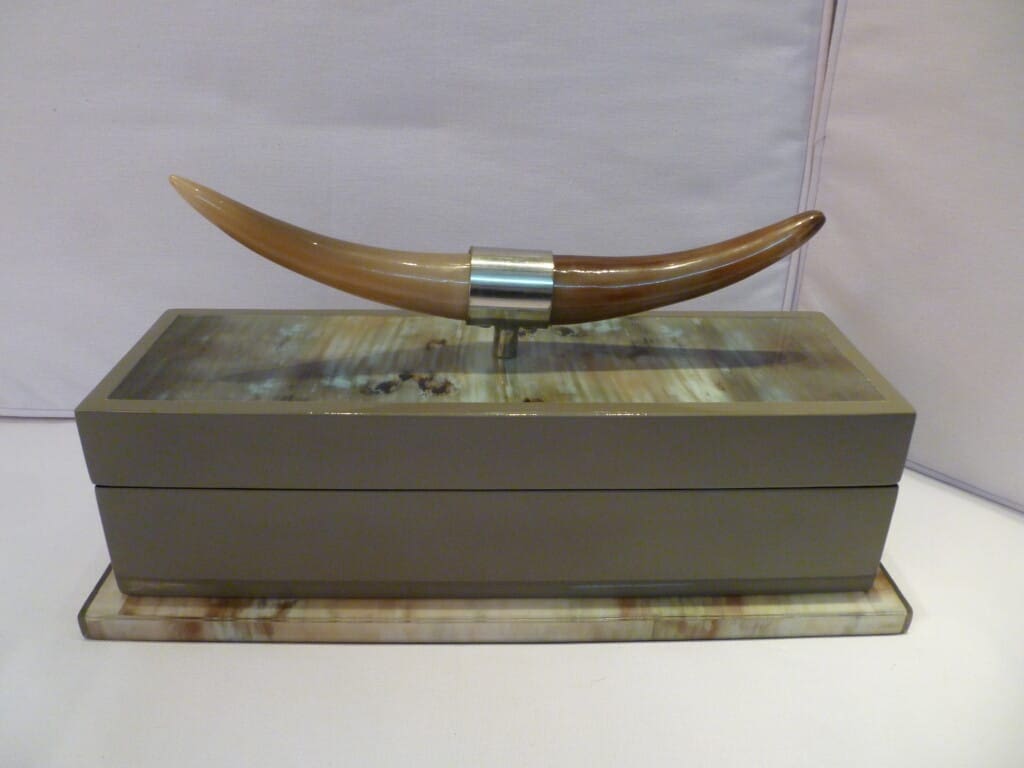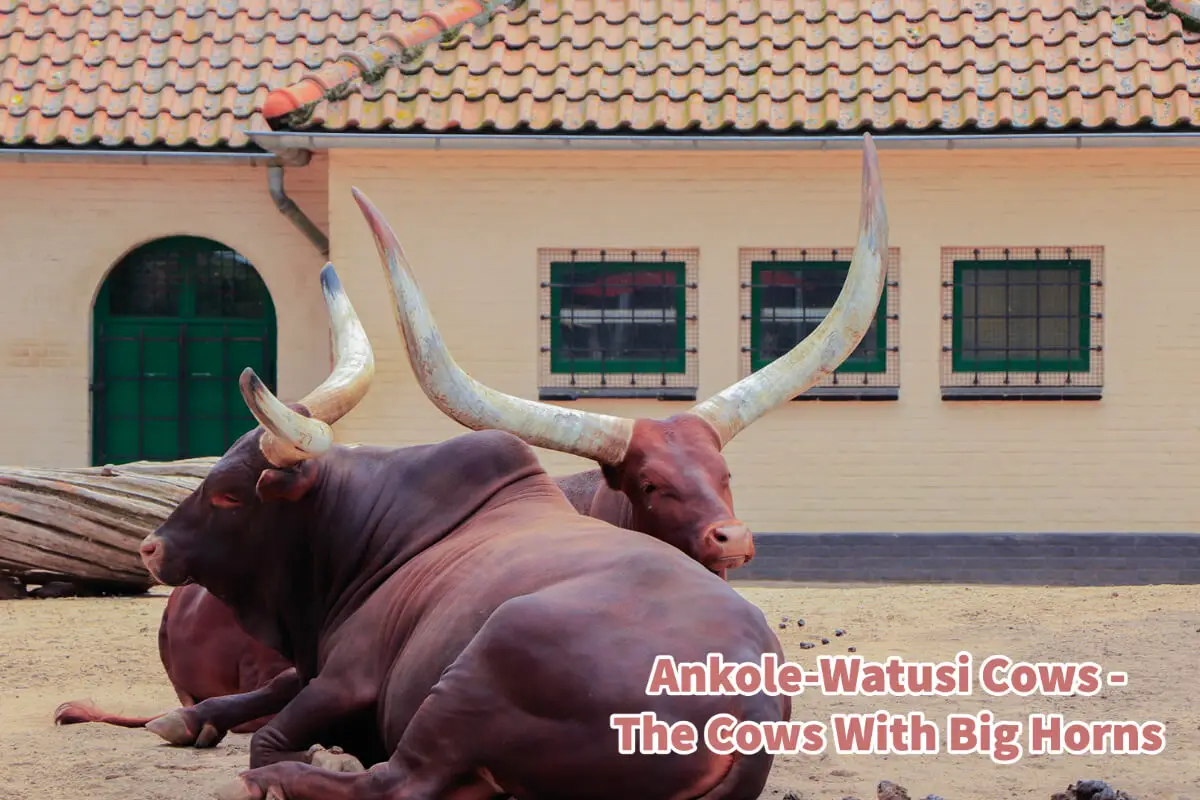Ankole-Watusi Cows are African cows that have big horns. The cow’s horns can also make jewelry and other high-end products.
Ankole-Watusi Cows, also known as the “cattle of kings,” is a domestic breed of cattle originating from Africa. They are found in the East African countries of Rwanda, Uganda, Burundi, and Tanzania and are commonly known for their long and distinctive horns. Read on as we explore where these cows are usually found, why they are called Ankole-Watusi Cows, and how their horns are used for home decor and other products.
Table of Contents
- Geography Of Ankole-Watusi Cows
- Why Are They Called Ankole-Watusi Cows?
- The Beautiful Horns Of Ankole-Watusi Cows
- Ankole-Watusi Cows Have Been Bred In African For Thousands Of Years
- 10 Reasons Why I Adore Ankole-Watusi Cow Horn Home Decor Products
- Frequently Asked Questions About Ankole-Watusi Cows
- Related Questions
Geography Of Ankole-Watusi Cows
Ankole-Watusi Cows are primarily found in the savannas and grasslands of East Africa. The cows are native to the region and are well adapted to the area’s harsh climatic conditions.

The climate in East Africa is hot and dry, and the grasslands provide the cows with the necessary nutrition to survive in harsh environments. Many African tribes raise these cows; they are often a symbol of wealth and power.
Why Are They Called Ankole-Watusi Cows?
Ankole-Watusi Cows get their name from their place of origin and their distinctive physical features. “Ankole” is a region in Uganda where these cows are found, and “Watusi” refers to the Tutsi people, the traditional keepers of these cattle.

The Tutsi people have a long history of cattle breeding and are known for their expertise in raising Ankole-Watusi Cows.
The Beautiful Horns Of Ankole-Watusi Cows
Ankole-Watusi Cows are known for their long and distinctive horns, which can grow up to 8 feet long in some cases. The horns are made up of a substance called keratin, which is the same substance found in human hair and nails.
The horns are used for several purposes, including defense against predators, regulating body temperature, and attracting mates. The horns are also used as a symbol of status and wealth in many African cultures.
Non-violent Use Of Ankole-Watusi Cow Horns
In many parts of the world, animals are killed for their horns to be used in traditional medicine and decorative purposes. However, Ankole-Watusi Cows are not killed in East Africa for their horns.
Instead, their horns can be shed, or the animals are killed for beef; the horns are the by-products of the cattle being bred and used for meat consumption.

Their beautiful horns are used to make jewelry, home decor products, and musical instruments. The horns are considered a sustainable resource, and their use generates income for many African communities.
Polishing And Using Ankole-Watusi Cow Horns
Ankole-Watusi cow horns are considered some of the most beautiful and unique in the world. They come in various colors, including brown, black, and white, and they can be polished to a high shine.
The polished horns make various products, including bracelets, necklaces, earrings, and rings. The horns can also be carved into bowls, cups, and other home decor items.
Ankole-Watusi cow horns also produce musical instruments like the African harp and trumpet horn. The horns are hollowed out, cut to the desired length, and fitted with reeds or mouthpieces to create the desired sound.
Ankole-Watusi Cows Have Been Bred In African For Thousands Of Years
Ankole-Watusi Cows have been bred in Africa for thousands of years and have a vital cultural significance for many African tribes. In addition to symbolizing wealth and power, they are seen as a sign of strength, endurance, and resilience.
The cows are highly valued for their ability to survive in harsh climatic conditions and their resistance to many common cattle diseases.
The Ankole-Watusi Cows are also considered a tourist attraction in many African countries. Visitors from all over the world come to see these beautiful animals and learn about their cultural significance.

At Mondoro, we make some products with the beautiful Ankole-Watusi Cow horns. These horns are imported from Africa and made into lovely products outside Hanoi, Vietnam. We will love to talk to you more if you want to manufacture Ankole-Watusi horn jewelry or home decor products.
10 Reasons Why I Adore Ankole-Watusi Cow Horn Home Decor Products
There’s something undeniably captivating about Ankole-Watusi cow horn home decor products that has captured my heart. These unique pieces effortlessly blend beauty, culture, and functionality.
Here are ten reasons why I adore these stunning additions to home decor:
1. Aesthetic Elegance:
Ankole-Watusi cow horns boast an exquisite natural beauty, with their rich, earthy tones and graceful curves, adding a touch of elegance to any space.
2. Ethical Sourcing:
I appreciate that these horns are sourced ethically, often as a byproduct of the meat industry, making them a sustainable and eco-friendly choice.
3. Cultural Significance:
Ankole-Watusi cattle hold cultural significance in parts of Africa, and incorporating their horns into decor pays homage to this heritage and celebrates the animal’s importance.
4. Unique Patterns:
Each horn is distinct, showcasing its own unique patterns and color variations, ensuring that every decor piece is one-of-a-kind.
5. Versatile Functionality:
From bowls and trays to furniture accents and lighting fixtures, these horns are incredibly versatile, allowing them to enhance various aspects of home decor.
6. Natural Warmth:
The warmth of Ankole-Watusi cow horn products adds a natural and organic touch to interior design, creating a welcoming and cozy atmosphere.
7. Texture and Contrast:
The texture and contrast of these horns create visual interest, whether used as handles on furniture or as decorative wall art.
8. Durable and Long-Lasting:
These horns are known for their durability, ensuring that they remain part of your decor for years to come.
9. Conversation Starters:
Guests are often intrigued and fascinated by these unique pieces, making them excellent conversation starters and adding depth to home decor stories.
10. Supporting Artisans:
Purchasing Ankole-Watusi cow horn decor products often supports local artisans and communities in Africa, contributing to their livelihoods and preserving traditional craftsmanship.
Incorporating Ankole-Watusi cow horn home decor products into my living space is not just about beautifying my surroundings; it’s a way of connecting with nature, culture, and history.
Their timeless elegance and versatility make them a cherished addition to any home, and the knowledge that they are ethically sourced and support local communities only deepens my appreciation for these remarkable pieces.
To learn more about how Mondoro can help you create, develop, and manufacture home decor and home furniture products – in African horn– don’t hesitate to contact me, Anita. Check out my email by clicking here or become a part of our community and join our newsletter by clicking here.
Mondoro gives out a FREE Lookbook to anyone interested. You can receive a copy of our latest Lookbook by clicking here.
Listen to our Podcast called Global Trade Gal. You can find it on all major podcast platforms. Try out listening to one of our podcasts by clicking here.
Subscribe to our Mondoro Company Limited YouTube Channel filled with great videos and information by clicking here.
Frequently Asked Questions About Ankole-Watusi Cows
What is the lifespan of an Ankole-Watusi cow?
The average lifespan of an Ankole-Watusi cow is around 20 to 25 years.
How tall can Ankole-Watusi cows grow?
Ankole-Watusi cows can grow up to 6 feet tall at the shoulder
What is the temperament of Ankole-Watusi cows?
Ankole-Watusi cows are generally known for being gentle and easy-going, but they can protect their young and may become aggressive if threatened.
Are Ankole-Watusi cows used for meat production?
Yes, Ankole-Watusi cows are used for meat production in many African countries, as their meat is considered high quality.
Can Ankole-Watusi cows be used for milk production?
Yes, Ankole-Watusi cows can be used for milk production, but they are not typically raised for this purpose.
How do Ankole-Watusi cows adapt to different climates?
Ankole-Watusi cows are known for their ability to adapt to different climatic conditions. They have a high tolerance for heat and can withstand long periods of drought.
How do Ankole-Watusi cows communicate with each other?
Ankole-Watusi cows communicate with each other through a variety of vocalizations, such as moos, grunts, and bellows.
What is the history of Ankole-Watusi cows in Africa?
Ankole-Watusi cows have a long history in Africa, dating back thousands of years. They have been bred for their horns, meat, and milk and have played an important cultural and economic role in many African communities.
Are there any conservation efforts to protect Ankole-Watusi cows?
Yes, there are conservation efforts to protect Ankole-Watusi cows and their habitat. Many African countries have established breeding programs and conservation areas to help preserve these animals.
How much do Ankole-Watusi cows weigh?
Ankole-Watusi cows can weigh between 900 to 1,600 pounds, depending on their age and sex.
Related Questions
What is the Mother of Pearl Shell Used in Home Decor Products?
Mother of pearl, known by the scientific name of nacre, is a pearl layer on the inner layer of the oyster shell. This pearl layer of the oyster is taken off the outer oyster shell. Then the leftover inner pearl shell is cut into various small shapes and sizes to be glued onto various home decor products such as mirrors, boxes, trays, and lamp bases.
You can learn more by reading our blog, What is the Mother of Pearl Shell Used in Home Decor Products? by clicking here.
The Ankole-Watusi Big-horned African Cow and Home Decor Products
The Ankole-Watusi big-horn African cow is a medium-sized cattle that have very longhorns. These cows are found mainly in Africa. The cow is not an endangered species so cows are sold as meat and the horns are then also sold to make home decor and jewelry items. This ensures that every part of the cow is somehow used and nothing goes to waste.
You can learn more by reading our blog The Ankole-Watusi Big-horned African Cow and Home Decor Products by clicking here.
What Is Spun Bamboo?
Spun bamboo was invented in Vietnam over 800 years ago as a way to give a cheaper alternative to the home decor and home utensil materials that were then being used. Spun bamboo is called spun bamboo as it is spun out pieces of bamboo, and then the bamboo pieces are glued together into a form. This production of spun bamboo helps women in these villages earn extra income. Spun bamboo is a great natural product and can be used in various home decor and kitchen products.
To discover more about spun bamboo you can read our blog on What is Spun Bamboo? Using Spun Bamboo in Product Development by clicking here.


